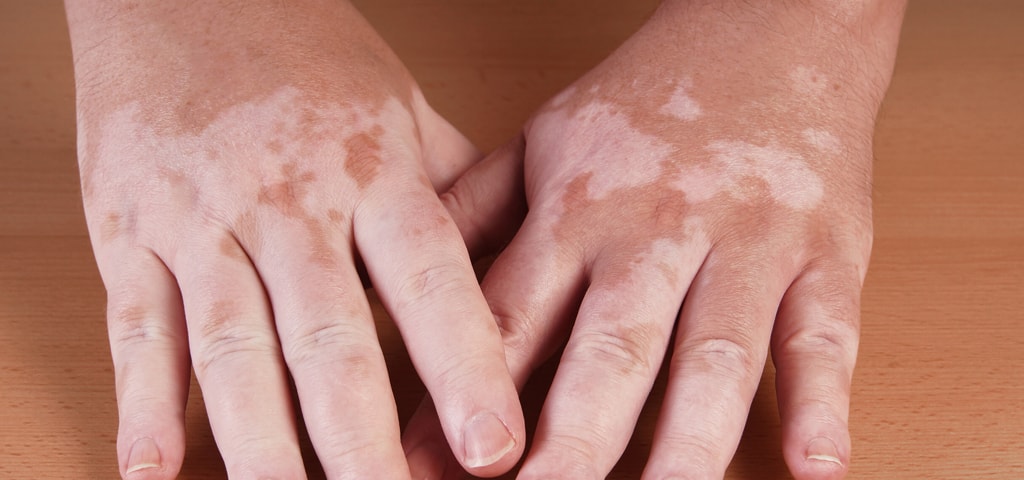Vitiligo (Leucoderma) is a condition where white patches appear in different parts of the body. It is relatively higher amongst the Indian population. It is a matter of concern as misconceptions about the disorder are higher and so is rejection in society.
Which part of the body can be affected?
Any part of the body can be affected such as hands, legs, head (scalp), soles, lips and mouth (Oral cavity) too. Any part of the skin and mucosa can be affected.
What causes these white patches?
The disease is autoimmune. One‘s own immune system destroys the melanocytes (pigment cells) in the skin. Genetic predisposition can happen for children whose parents have the disease are more likely to develop it. At times, deep injuries or burns where the deeper layers of the skin are affected can also cause vitiligo (Leucoderma). Emotional stress can cause a flare condition or trigger the disease process. It is associated with hyperthyroidism or hypothyroidism.
Which age groups gets affect?
Any age group can develop vitiligo. This disorder affects all races and sex equally. White skin people usually don’t bother much about it as it doesn’t show as much as in darker skin individual. In India, the prevalence rate is higher (2%).
How to assess if it will spread all over the body?
There is no way to predict the course of the disorder. For some patients, the patches just remain stable. Few experience rapid spread of the condition. Some patients complain of itching during spread. Physical and emotional stress can aggravate the condition. There are many ways to control the spread of the disorder. So the earlier, the patient approaches the doctor is better.
Myths about vitiligo:
Vitiligo is not a contagious and does not spread through touch. This is not a life threatening disorder and does not affect any other system in one’s body.
Treatment:
Treatment modalities for vitiligo are many. The goal of the treatment is usually to stop the spread of the disorder and restore lost skin color.
NonSurgical Methods:
Cosmetic makeup:
Cosmetic makeup is done to color your skin and these can help the patient get back their confidence. Self-tanners are also available and have to be used regularly to retain the color.
Oral medications:
Oral medications are available which stop the white patches from spreading and oral psoralens also help re-pigmentation. These medications should be prescribed by registered doctors.
Topical applications:
Topical applications like cream help re-pigmentation. Topical psoralens solutions are also used to re-pigment the skin. There are a lot of constraints in using topical applications. Small parts are more effective and usually face helps more than limbs or body parts which are less exposed to sunlight.
Light Therapy:
Light therapy is very effective. PUVA therapy has been used for many years and is outdated now. It has a few side effects and is very slow in repigmentation.
Narrow Bend Ultra Violet B (UVB):
Narrow Band Ultra Violet B (UVB) is the latest in Light therapy and has minimum side effects. Re- pigmentation is faster and it also helps to control the spread of the disorder.
High power Narrow Band UVB:
High power Narrow Band UVB is the most effective in re-pigmentation but is limited to smaller areas.
Surgical Procedures:
Suction Blister Technique:
Blisters are made with special equipment on the normal skin and the top layers of these blisters are used as skin grafts, which are fixed on the white patches. The skin around the lips and eyelids (skin is very thin) are ideal for this technique as cosmetic results are very good.
Split Skin Graft:
It is a very common procedure. A graft is taken from the normal skin with special knives and transferred to the white patches. Very large areas cannot be treated with this procedure.
Melanocyte Transfer Surgery:
The advantage of this surgery is that the larger area can be treated with small grafts. White patches up to 100 sq.cm can be treated in one session. This procedure needs only a short time and repigmentation is done within a short time span of 3-6 months.
There are laser treatment and some medications which are used very judiciously in resistant cases (patients not responding to any treatment).
Vitiligo is one disorder which does not affect a person physically but the mental trauma caused is unfathomable.
Also Read: Prenatal Screening | Traumatic Stiffness Of Elbow Joint | Physical exercise for heart

